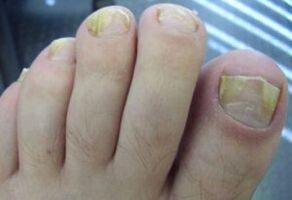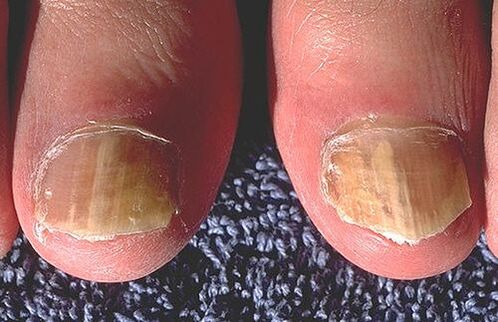Any varieties of nail fungus are most common.The harbingers of their distribution are pathogenic mushrooms.In this case, the transfer of an unpleasant ailment to other persons is possible.Most of all, households and the close environment of the patient are subject to this.
Such a pathology is an unpleasant phenomenon due to which many problems arise.When observing the first signs, you need to visit a medical institution.During visual inspection and further study, it will become possible to prescribe the most effective treatment.Only following the prescriptions of experts will help to defeat the disease.

A little about the disease
What is nail fungus?Mycosis is a dangerous pathology, due to which the skin is infected with various types of fungi.However, they can spread to others near the located areas of the skin, even throughout the body and upper limbs.
Feet infection encourages the development of problems in the epidermis cells, forming insignificant cracks on the heel.Symptoms are slightly different, since there is a characteristic variety of the disease.
But basically it can be attributed to it: peeling, itching, specific smell, skin stratification.The fungus on the legs is manifested due to disorders of metabolic processes, weakening the immune system, the presence of endocrine diseases.The probability of its development also increases if a person has diabetes, purulent and bacterial inflammation of the skin.
Varieties
Varieties of nail fungus on the arms and legs are often found due to certain pathogens, which after reveals the necessary treatment.There are also some forms of disease.That is why it is advisable to be examined in time and follow the doctor’s recommendations, because this will accelerate the process of recovery.
Forms of the disease
The manifestation of signs of peeling and itching on the skin is attributed to the development of pathology, and this is only the initial stage.What is the nail fungus on the legs?In most cases, the development of the fungus on the legs begins with the fingers and between them.
After that, minor cracks and inflammation of the epidermis appear.Thus, the disease, symptoms, and therapeutic measures are revealed after finding the cause of the disease.All this leads to remission or further spread of the neoplasm.
- SquamousThe form is characterized by edema of the lower extremities, peeling between the fingers and itching is observed.At this moment, the nail plate begins to collapse, so some changes undergo color and shape.It is necessary to find a pathology in time.Contributing signs and causes are capable of this.In this connection, it is worth carefully observing the slightest changes on the skin.It is possible to independently conduct initial treatment with ointments.But this may not have the proper effect.If this happens, you will need to use specialists.
- HyperkeratoticThe form is accompanied by the emergence of characteristic features.It can be itching, dry skin, color change, peeling and stratification.After that, the person pours, as a result, the epidermis resembles a cup.Distribution occurs quite quickly.Strong pains are felt when touching, the smell of rot.
- Intriginousform.At the slightest suspicion of the presence of a fungus, it is worth determining its character.Symptoms can contribute to this: humidity, swelling, deep cracks.At the same time, painful sensations are pronounced, and the progression of the disease is accompanied by a specific smell.
- Dyshidroticform.It can be easily detected: the entire surface of the skin is covered with blisters.And this is observed not only on the lower, but also on the upper limbs.If they burst them without the permission of a specialist, then you can see erosion of a reddish shade.Reling will arise on the leg, sometimes an unpleasant consistency flows.
Only a professional is entitled to detect characteristic symptoms, and subsequently prescribe treatment.He is a dermatologist.You can also identify a suitable diagnosis using a thorough examination.Based on the results obtained, an effective technique is prescribed that contributes to a speedy recovery.
Pathogens
The skin on the feet and hips infects several types of neoplasms.To most accurately establish treatment, you need to find out which fungus causes the nail fungus.This will require the initial inspection and delivery of certain analyzes.In general, there are 3 groups of fungi, this is:

- Dermatophytes;
- yeast;
- molds.
The former begin to manifest themselves in contact with certain pathogens.At first glance, this form stands out in bright colors: mainly yellow and gray.But on the nails they are represented in the form of strips of small thickness.
At the same time, the plate begins to move away from the base, and the skin dries.This form is most common in people.In addition, it can spread far beyond the nail plate.
The latter manifest due to the pathogen-Candida.The presence of an incomprehensible consistency of a white color is considered a characteristic phenomenon in damage.It applies to neighboring surfaces only if there is a weak immune system, excessive setting of sweat.In practice, it is practically not detected, but lends itself to treatment.
The third, in most cases, focus on the nail plate.In this case, characteristic manifestations arise: destruction, detachment, color change, formation around small bubbles.After that, the epidermis is exhausted, which is accompanied by cracks, painful sensations and minor blood loss.Also, people complain of itching, which is able to manifest themselves at night.
Symptoms
The first two main symptoms of nail fungus are skin dryness and itching.The manifestation of these two symptoms is already an occasion to see a doctor for diagnostics.However, these symptoms also appear with vitamin deficiency, dehydration, or simply from dust exposure.The fungus at this stage can only be diagnosed in the laboratory.
Another symptom of the fungus is to change the color of the affected nail plate.It is mainly yellow or brown.In addition to the color of the nail plate, some changes are also inherent:
- the nail is damaged in the edges;
- transversely located wave -shaped;
- Small grooves;
- light spots that increase after some time;
- Coloring or stratification of the nail.
Unfortunately, often women write them off on poor quality varnishes, unprofessionalism of the master in the cabin and the consequences of other cosmetic procedures.
In the presence of these symptoms, you should immediately consult a doctor, otherwise the fungus will slowly but correctly absorb the nail completely.
Often people come to the doctor already in an advanced stage.However, if you do not contact a doctor in an advanced stage, then you can survive to the fungal damage to the whole organism, especially if a person bites his nails.
Diagnostics
There is one interesting method that will help you at home determine whether the nails are affected by a fungus or not.
The essence of the method: Pour warm water into a small bowl and add a little potassium permanganate.After lowering the finger into the solution for several minutes and check whether the nails have changed the color.Healthy nails will be brown, and the infected ones will remain light.
You can also answer a few questions below:
- Did the nail plates on the arms or legs have changed outwardly?
- Are the nail plates relax or crumble?
- Is the skin dry?
- Previously, they hurt fungal infections?
The probability of the disease is high if you answer positively to almost all questions and you should immediately consult a doctor for help.
Diagnosis of the disease has the right to perform a dermatologist.He is able to identify the cause, variety.Based on the results obtained, effective treatment is prescribed.But the tests must be taken in a medical institution, not at home.This will make the most accurate research.
Methods of treatment
The choice of the right method of treatment is made only after the diagnosis and identification of the type of pathogen, due to which the defeat occurred.
But still it is worth keeping in mind that fungal damage requires a certain treatment: with the help of medicines, traditional medicine, and other methods.
Before starting the use of a particular method, you need to verify the correctness of the diagnosis and reduce the inflammatory process.
- Intensive therapy complex where ointments, cream, sprays are an important component.
- The need to comply with the rules for taking antimycotic medicines.
- Antihistamines can be used if unbearable itching and peeling are observed.Moreover, other methods do not have the proper result.
- Vitamins and minerals should also be consumed as single products or in conjunction with any means.This will protect the body from external stimuli.
- If bacterial infection of the human body often occurs, then the course of medicines aimed at eliminating characteristic symptoms can help alleviate the condition.
Only after the doctor prescribes a detailed recommendation for taking this or that tool, it is possible to observe the effect.However, when prescribing, varieties of the fungus, age -related qualification, localization and nature of the lesion are taken into account.
A large number of medicine manuals reveals a photo of the dermatophyte of the nail, complications, treatment, some features of the current.
Why the nail fungus does not pass
Reducing local immunity is the main reason that the fungus has firmly settled on the nails.When the body does not cope with the invasion of pathogenic organisms, there is a constant repeated infection, even if the patient is relatively healthy.Other factors that are provocateurs of fungal infections are such:
- constant contact with a humid environment (for example, work in the pool, on the beach, in the mine);
- non -compliance with personal hygiene rules;
- increased blood glucose (sugar is a favorite nutrient for a parasite);
- chronic nail injury (for example, when wearing tight shoes with narrow socks);
- Contact with the carriers of the fungus (for example, if one of the family members is infected).
It is difficult to defeat the nail fungus in severe forms with the help of pharmacy outdoors.Various antifungal ointments, sprays, creams, patchings need to be combined with internal drugs.It is known that the fungal infection affects not only nails: particles of parasitic microorganism are also on internal organs, mucous membranes.You can get rid of them using a course of antimycotics - tablets for internal administration for at least 2 weeks.
How to care for nails with a fungus
The advanced shape of the nail fungus also requires regular care every day.It is necessary to wash your legs daily, wear clean socks, ventilate and disinfect shoes.You can use only personal towers for the legs, manicure tools.Alien shoes, even domestic slippers, is forbidden to wear.It is also impossible to give your shoes, scissors, files and other things in contact with your nails.
If the products from the nail fungus on the legs with a neglected form do not give a result, you need to contact a dermatologist, which with the help of special drugs will remove the affected plate and apply an antiseptic drug.This procedure is carried out in a medical office, after which you need to carefully take care of the fingernail until the nail plate is completely updated.
If there is a fungus of nails on the legs in an advanced form and is still not known than to treat it due to the inefficiency of fixed assets, you need to undergo a more thorough examination of the body and determine the immune status.Many immunodeficiency factors have a hidden nature and can manifest in chronic infectious diseases, includingLike a fungus.If the traditional treatment of nail fungus is ineffective for 2-3 months, you need to contact an immunologist.
Prevention measures
A special danger of the development of the fungus should be expected from excessive sweating.This is aggravated by the fact that the feet do not breathe, because oxygen overlaps dense shoes.A person needs to have an idea that he can occur at minus temperatures.But even does not die, but continues to spread bacteria.
High temperatures, on the contrary, contribute to the death of a pathogenic organism.It is only necessary to influence the feet and upper limbs with steam or hot water.This method also applies to clothes: you can wash or iron the product to get rid of the fungus.
















